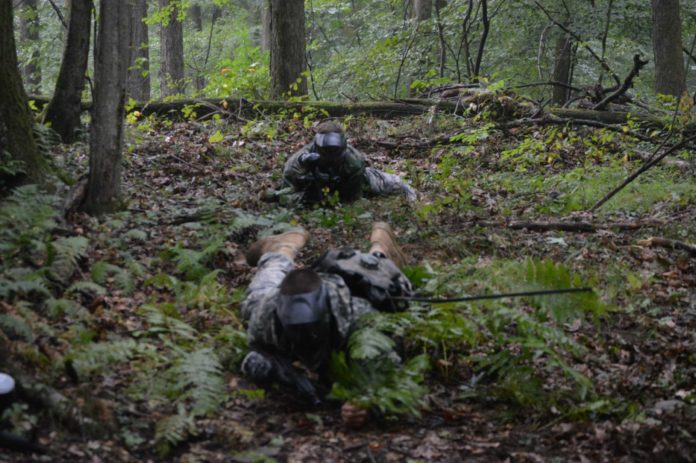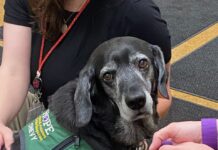Slippery Rock University’s Reserve Officers’ Training Corps (ROTC) took part in a weekend-long Field Training Exercise (FTX) during which all parties involved were able to put their skills to the test, while also learning new ones.
The objective of the FTX training was to apply the Army Leadership Requirements Model in a challenging, tactically based exercise while training field craft, grit, and these 21st Soldier competencies.
“This past weekend was my first time ever as a squad leader and I didn’t really know what to expect or how it would go,” Cadet Isti Istrefi said. “I spent three nights before we left studying the cadet handbook and just trying to refresh my memory since I had gone most of the summer without any form of training.”
The FTX took place at the McKeever Environmental Learning Center, located in Sandy Lake, PA, an SRU managed property, otherwise called Atropia. The Atropian base hosted not only SRU’s ROTC, but also Clarion’s. The unit was configured in two platoons rotating through SQD and Platoon missions.
“When we set foot on McKeever, I was excited for it was a field exercise and nervous for I would be in a leadership role,” Cadet Evan Razzano said. “I love being in the field, it builds character, discipline and esprit de core. The field creates teamwork and trust. You learn to trust those on your left and right side. I was nervous as this was my first field exercise which I was in a leadership role. It takes a lot to lead and to lead well. I was nervous to fail in leading those under my command.”
Friday night saw the cadets being briefed MSIVs (seniors), who rotated through eight Platoon Leader/Platoon Sergeant positions. MSIIIs (Juniors), who rotated through 24 Squad Leader opportunities, were then set loose to come up with their plan of attack against the enemy, the Ariana. MSIIs (sophomores), who rotated through 48 TL (team leader) opportunities, were to pull security on base, with MSIs (freshmen).
“Most of everything that we had to do was pretty basic by the book stuff,” Cadet Istrefi said. “The hard part about the planning phase was figuring out the proper format of how you wanted to word things when it came time to briefing your squad. It comes down to utilizing your resources, whether that be other cadets, handbooks, or even cadre members. “
Saturday was a day full of missions for the cadets, where each squad participated in Lane Training Exercises (LTX). The first task was to ID possible SAPA cache in order to disrupt IED network. The second task was to engage with Atropian Squad Leader in order to support Atropian border security. The Squad Leader was provided intel on future SAPA locations. The third task was to destroy SAPA team in order to protect Atropian flank. The final task was to destroy reinforcing SAPA team in order to secure Atropian border.
“I was so ready to take on the SAPA forces,” Cadet Istrefi said. “Having spent all night planning my mission, I was excited to finally get a chance to put it into action and just see how things turned out. Obviously this was a learning environment, so what I was the most excited about was getting feedback and seeing what I needed to work on as a future officer in the United States Army.”
On Sunday, the cadets were able to experience one final battle, where one platoon remained the US Platoon and the other became the Ariana Platoon.
“It’s all fun and games and learning,” Cadet Istrefi said. “At the end of the day, we’re all still going to be friends. It’s all about the bragging rights.”
The US Platoon was missioned to defeat the Ariana Platoon in order to restore the international border. The Ariana Platoon was missioned to destroy the US Platoon in order to allow passage of follow-on forces.
“I thought the big mission was great training,” Cadet Razzano said. “It brought the elements of Saturday’s lanes into one big exercise. It took the actions of a small squad to a whole platoon. The mission help show how a platoon mission was Saturdays actions.”
Throughout all of the training the cadets had to endure conditions like sleeping outside in the woods Friday night, eating Meals Ready to Eat (MREs), which are the exact meals soldiers eat, and give up hygiene for a weekend and live in their Army Combat Uniforms (ACUs) for the duration of the weekend.
“I find the field is the best training there is,” Cadet Razzano said. “I do not mind any of lack of sleep, hygiene, or modern commendations when camping. It builds discipline and trust. It will build character in those who do not think they could survive outside. I suffered, but I know my fellow cadets/soldiers suffered too. We sucked the suck together, which in the end binds a fighting team together. Since the beginning of history of the Army, was composed of men and women who left the comforts of their home to fight, train, and sustain America’s freedom.”
For those who never experienced a formal FTX, the conditions could be less than satisfactory, but for MSIII Cadet Istrefi, she has a way of putting everything into perspective.
“The best way to cope with most things in ROTC is realizing that there are people, real life soldiers out in Afghanistan and Iraq that are sacrificing their lives every day,” Cadet Istrefi said. “Who am I to complain about an MRE, when some haven’t eaten a real meal in days. What kind of person would I be if I complained about having to sleep outside for a weekend when there are soldiers that haven’t slept in their own bed in over a year? It just comes down to realizing that, it’s really not that bad and that there are people in far worse situations than you making the best of it. Keeping a level head is so important.”
Seeing as though this weekend was a training exercise, every cadet has improvements to work on for future FTX weekends.
“There are many aspects we can improve on,” Cadet Razzano said. “We still have a lot of improvement from each platoon to get better at tactics and battle drills. The MS3 still have a little bit to go to be experts to OPORDS.”
The weekend ended with a formal After Action Review (AAR), where the cadets discussed every aspect of the FTX and what needs to be sustained or improved upon for the next experience.
“These simulations definitely help get someone combat ready,” Cadet Razzano said. “Now this is just a small and simple FTX. There is bigger and more complex LTXs or FTXs. Yet for the MS1’s or anyone who has not done a LTX/FTX. This gives a little taste of what actual combat is. It also helps simulate a setting of combat that being in the classroom or white board cannot. In the end, this type of training brings everything learned from the classroom and labs, to simulation of the complexity of combat. It builds character, soldiers/cadets, and overall leaders.”








